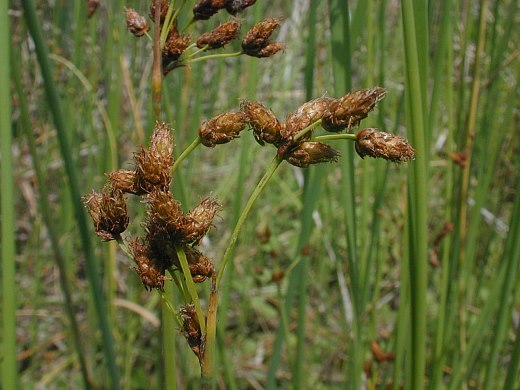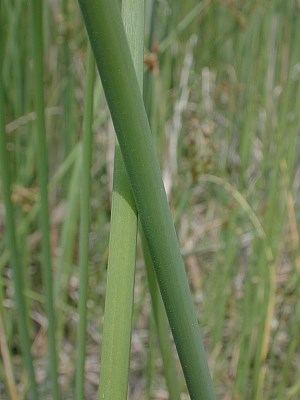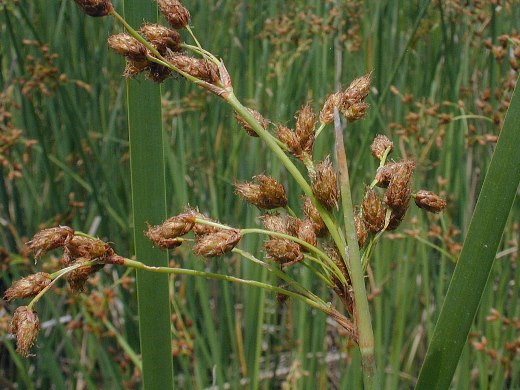Description: This perennial wetland plant is unbranched and 4-8' tall. The central culm is more or less erect and usually curved slightly to one side. This culm is dull green, terete, and soft from a spongy interior; it is up to 1/3" (8 mm.) across at the base, becoming more slender upward. At the base, there are several membranous leaf sheaths that wrap around the culm; these sheaths lack leaf blades, or if such blades are present, then they are quite small and insignificant.

Each fertile culm
terminates in a single inflorescence spanning up to 6" long and 6"
across. This inflorescence consists of a compound umbel or panicle of
spikelets
and a single basal bract about ½–3" long; this basal bract looks like a
continuation of the culm. The branches and branchlets of the compound
umbel are widely spreading and somewhat drooping; they are light green,
flattened, and slender. Each branchlet terminates in either an
individual spikelet or a dense cluster of 2-5 spikelets; the spikelets
in each cluster are sessile or they have short pedicels. Each spikelet
is about 6-8 mm. (1/4–1/3") in length and ovoid or ovoid-lanceoloid in
shape, consisting of a compact head of perfect florets and their
overlapping scales. The spikelets are brown to reddish brown and hairy
in appearance because of the persistent bipartite styles (which become
contorted and brown with age). The styles of the florets are white
during the blooming period. The scales are ovate, brownish, and about
2.5–3.0 mm. long; each scale has a green central vein that may
terminate in a very short awn. The blooming period occurs during the
summer; the florets are wind-pollinated. Each fertile floret produces a
single achene about 1.5–2.5 mm. long that is obovoid and brown; at the
apex of each achene, there is a short slender beak. Each achene is
surrounded by 4-6 bristles that are as long as or a little longer than
the achene. The root system is fibrous and strongly rhizomatous. Dense
colonies of vegetative plants are often formed from the rhizomes.
Cultivation:
Great Bulrush prefers full or partial sun, wet conditions, and soil
that is mucky or sandy. This species is easy to cultivate in wetland
areas (including shallow water), but it can spread aggressively.
Propagation is easiest by division of the rhizomes.

Range &
Habitat:
The native Great Bulrush is common in central and northern Illinois,
while in many
areas of southern Illinois it is occasional or absent (see Distribution
Map). In addition to North America, this species (or very
similar species) can be found in Eurasia and other continents. Habitats
include wet prairies, marshes and sandy marshes, swamps, borders of
lakes and ponds, swales and sloughs, interdunal depressions, and
ditches along roadsides and railroads. Generally, Great Bulrush is
found in wetland areas where there is little wave action, which can
damage its soft stems. This species thrives in wetlands with a history
of disturbance, but it is also found in higher quality wetlands.
Faunal Associations:
The following information about insects applies to Scirpus
spp. (including Schoenoplectus spp.) in
general. The larvae of several leaf beetles (mostly Donacia spp.
& Plateumaris spp.) feed on the submerged
stems or roots of bulrushes; the Leaf Beetle Table lists these
species. The caterpillars of the moths Archanara oblonga
(Oblong Sedge Borer) and Archanara subflava (Yellow
Sedge Borer) bore through the stems of some bulrushes, as do the larvae
of the Scathophagid fly, Cordilura varipes. The
seed bug Cymus luridus feeds on the seedheads.
Among vertebrate animals, the seedheads of Great Bulrush and other
bulrushes are an important source of food to many wetland birds,
particularly ducks (see Bird Table for a listing of these
species). Dense colonies of Great Bulrush also provide cover and
nesting material for many birds. Muskrats feed on the foliage and
rhizomes.
Photographic Location:
Edge of a pond at the Arboretum of the University of Illinois in
Urbana, Illinois; also a roadside ditch in the same city.

Comments: This is the tallest bulrush in Illinois; it is a reliable indicator of wet conditions. There are several scientific synonyms for this species, including Scirpus validus, Scirpus tabernaemontani, and Scirpus lacustris validus. Sometimes 'tabernaemontani' is spelled incorrectly as 'tabernaemontanii.' Another common name is Soft-Stem Bulrush. Great Bulrush differs from other bulrushes (Schoenoplectus spp., Scirpus spp., etc.) by its great size, lack of significant leaf blades, and soft culms. The culm-like bract of its inflorescence is short (less than 3" in length). This species resembles the closely related Schoenoplectus acutus (Hard-Stem Bulrush; a.k.a. Scirpus acutus) and Schoenoplectus heterochaetus (Slender Bulrush; a.k.a. Scirpus heterochaetus). Hard-Stem Bulrush has harder culms and slightly longer floral scales (3-4 mm.), while Slender Bulrush has 2-4 bristles per achene and the styles of its florets are tripartite. These latter two species tend to be smaller in size than Great Bulrush and they are less common.